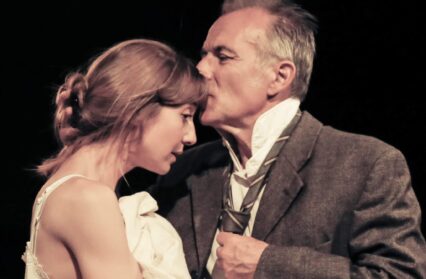As Company of Sirens and Gary Raymond join forces for, A Beautiful Rhythm of Life and Death, a new play which explores the life and work of Welsh writer Dorothy Edwards, Emma Schofield takes a moment to reflect on why it’s high time for one of Welsh writing’s most overlooked figures to be brought out of the shadows.
“All the time while Sorel played, while the melody fell wailing away from his fingers, and then at the end when only the dark rhythm of the dance was left, he could see Leonora quite clearly in the air in front of him.”
I first read those lines from Rhapsody as a student, more years ago than I now care to remember, when I started reading Dorothy Edwards for a module I was taking on Welsh writing in English. They stuck with me, as words so often do, but I don’t recall ever really talking about them with anyone else. In all honesty, it’s not easy to talk about Dorothy Edwards, staggeringly few people will know who you are talking about and even less will have read anything by her.
Which is why I was so surprised when it turned out that a play was being written about her. I’ve worked with Gary Raymond, through Wales Arts Review, on and off for over a decade; he’s a friend as well as a colleague, we talk most days and I knew that he was working on a play with Chris Durnall and Company of Sirens. It had been mentioned briefly, mainly over coffee, that he was developing something and I had nodded along, half-assuming that it might be a play about Newport, perhaps set in a pub, with each of the patrons propping up the bar as they told their own stories. Think a modern-day Canterbury Tales, but in theatre form.
It wasn’t until I got the invitation to the Research and Development showcase last October that I discovered that the play was, in fact, about Dorothy Edwards. In our, admittedly, lengthy and rambling conversations about Welsh writing, we’d never discussed Edwards. I had no idea that Gary had delved into her writing and found himself drawn into the life of the woman whose image in the book jacket is every bit as striking and combative as the stories she wrote, much less that he was planning to bring her to life on the stage. My response was enthusiastic, I’m nothing if not a supportive friend and the idea that Edwards would be brought to new audiences through a play was certainly exciting, but privately, I was also a little apprehensive.
You see, the problem with Dorothy Edwards is that those who have heard of her have almost certainly heard of her because of how she died. If you’re planning on writing a play about Edwards, her death is, undeniably, the elephant in the room. Arguably the most well-known fact about her is that at the age of just 31 she spent an afternoon burning letters and a copy of her unpublished novel, before walking a considerable distance from her mother’s home near Treforest to throw herself in front of a passing train near Caerphilly train station. We know little about that journey, except that she was barefoot at the time and her shoes were never found, but her suicide note is well-publicised. The note detailed her decision to kill herself because “I have never sincerely loved any human being all my life. I have accepted kindness and friendship and even love without gratitude, and given nothing in return”. It’s an uncomfortable note to read, not least because it also taps into a fear that many of us have felt in our lives at some point that love will somehow pass us by in the way Edwards clearly felt it had. Navigating that sense of despair in a play, without allowing it to dominate the entire story, struck me as no easy task. As is so often the way, Edwards was so much more than her death. A powerful writer, a passionate socialist and a firm believer in the cause of Welsh nationalism, she was a woman who knew her own mind and wasn’t afraid to speak it, capturing that through a 90 minute play is an enormous ask.
Thankfully, the opening night of A Beautiful Rhythm of Life and Death was an opportunity to breathe a sigh of relief. What Gary and Chris Durnall have crafted is a play which opens with that moment of utter despair, an opportunity to release that tragedy and frustration in the opening seconds of the play. Angharad Matthews in the role of Dorothy Edwards, takes charge immediately, purposefully marching onto the stage and disrupting the piano music being played by Stacey Blythe by crashing her hands into the piano and then delivering the lines from the suicide note, arms outstretched, head back, braced for the blow which is to come. It’s vulnerable and powerful in equal measure, an assured start to a play which has clearly evolved since that first development showcase last year.
I mention the music, because of course there is music, there had to be. Music is everywhere in Edwards’ work, in the sonata form used in her 1928 novel Winter Sonata and thematically within so many of her short stories; it’s difficult to imagine how Edwards’ own story could be told without music. At some point we’ve all wished that we could have a song playing at key moments in our lives, perhaps even thought about what music we would choose to accompany an entrance or exit. Here, the assured hands of Stacey Blythe go further than that, Blythe never allows the music to impose or to dominate, instead it enhances Angharad Matthew’s Dorothy, reflecting her thought process and accentuating those moments of drama or sorrow in a way that only music can do.
And there is sorrow. Whichever way you look at it, Edwards’ life was one which contained much sadness. The death of her father, the man who had inspired her socialist beliefs and instilled so much belief in her, was a bitter blow to Edwards, as was the uncomfortable 11 months she spent in London as part of the Bloomsbury group, where it became increasingly clear that she did not fit in and around which, much of the play centres. Drawing on the nuances of the script, Matthews is able to capture the discomfort of a woman who finds herself increasingly isolated by her refusal to conform to type. The ease of the two-hander between Matthews and Jâms Thomas enables the pair to tackle the complexity of her relationship with sponsor David Garnett and her increasing frustration at being expected to conform to a notion of Welshness to which she did not subscribe. What we see, through the glimpses of Edwards in this play, are the internal struggles of a young writer who was often as dislocated as she was isolated.
Yet within that sorrow, there is also hope. As the play unfolds in reverse chronological order, we see a different side to Edwards; there is a playfulness, a passion for politics and an acute awareness of how her role as a woman in the interwar period is so finely balanced between the pull of the past and the potential for a very different future. Here again, the music is key, mirroring the glimmers of excitement which sometimes burst from Matthews’ Edwards, as well as underpinning her frustration at not being taken seriously. There is a poignant scene where aspiring opera singer Edwards recalls being at a party and offering to sing, suggesting a number of renowned classical composers, before eventually being cajoled into singing a Welsh folk song she remembers from her childhood. In every scene that hope of being taken seriously hangs in the air just long enough for it to deliver a sharp jolt when it’s snatched from within her grasp.
Then, inevitably, there is love. In spite of Edwards’ suicide note, we know that there were at least some relationships in her life in which she explored the possibility of love. A Beautiful Rhythm of Life and Death touches briefly on the breakdown of her engagement to her university professor, John Thorburn, and her brief affair with a married cellist, Ronald Harding. Love has its own rhythm; for many of us it can take years to find, often faltering through false starts and broken movements, before striking with an intensity that is impossible to resist. That particular rhythm may ultimately have eluded Edwards in her lifetime and yet, there was love of a different kind. The relationship the play gives most credence to is her blossoming friendship with Glyn Jones, whom she met by chance while studying at University, touching on the exchange of ideas and the mutual respect which built between the two. Jones was, perhaps, one of the only men Edwards was ever genuinely in awe of, a fellow writer and scholar who she felt understood her and was able to challenge her in a way that others simply could not. As Matthews and Thomas come together, as Dorothy and Glyn, to dance to Chopin, it’s impossible not to feel the bleakness of that suicide note fading into the background.
The play runs throughout this week at Chapter Arts Centre, but talking to Durnall afterwards it’s very clear that he hopes this will be just the beginning for a play which offers so much, both as a powerful piece of theatre, but also as an opportunity to shine a light on the work of a Welsh writer who so richly deserves wider attention. For Durnall, the play is still evolving, something he hopes it will continue to do over the coming year, perhaps taking that story of the “Welsh Cinderella” out into the world to find new audiences both for the play, and for Edwards’ work. It seems fitting that almost ninety years on from her death, Edwards’ writing should be resurrected and her story told in a way which focuses not on her untimely end, but on the vibrancy and passion of her life.
I say life, because, ultimately, this is a play about life. When the music stops and the rhythm of the script comes to an end, what we are left with is the image of Dorothy Edwards, the writer and the woman, quite clearly in front of us, full of hope and passion, and utterly impossible to forget.
A Beautiful Rhythm of Life and Death runs at Chapter Arts Centre until Saturday 3rd June. Tickets are available here.











